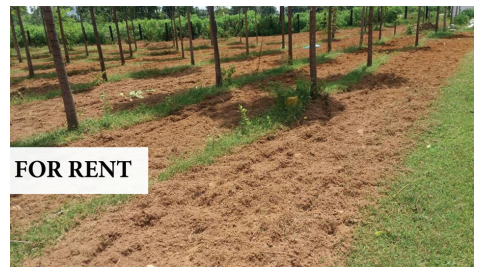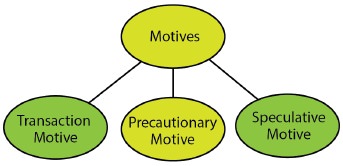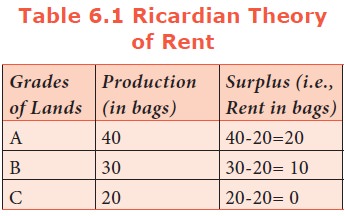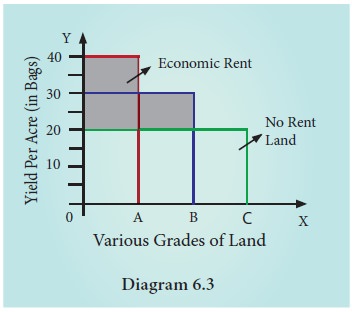Meaning, Ricardian Theory of Rent, Quasi-Rent, Modern Theory | Economics - Rent | 11th Economics : Chapter 6 : Distribution Analysis
Chapter: 11th Economics : Chapter 6 : Distribution Analysis
Rent
Rent
1. Meaning
Rent is
the price or reward given for the use of land or house or a machine to the
owner. But, in Economics, “Rent” or “Economic Rent” refers to that part of
payment made by a tenant to his landlords for the use of land only.


2. Ricardian Theory of Rent
The
Classical Theory of Rent is called “Ricardian Theory of Rent”. David Ricardo
explained the theory of rent thus:
Assumptions
Ricardian
theory of rent assumes the following:
“Rent is
that portion of the produce of the earth which is paid to the landlord for the
use of the original and indestructible powers of the soil”.
- David Ricardo
1.
Land differs in fertility.
2.
The law of diminishing returns operates in
agriculture.
3.
Rent depends upon fertility and location of land.
4.
Theory assumes perfect competition.
5.
It is based on the assumption of long period.
6.
There is existence of marginal land or no-rent
land.
7.
Land has certain “original and indestructible
powers”.
8.
Land is used for cultivation only.
9.
Most fertile lands are cultivated first.
Statement of the Theory with Illustration
Assume
that some people go to a newly discovered island and settle down there. There
are three grades of land, namely A, B and C in that island. ‘A’ being most
fertile, ‘B’ less fertile and ‘C’ the least fertile. They will first cultivate
all the most fertile land (A grade) available. Since the land is abundant and
idle, there is no need to pay rent as long as such best lands are freely
available. Given a certain amount of labour and capital, the yield per acre on
‘A’ grade land is 40 bags of paddy.
Suppose
another group of people goes and settles down in the same island after some
time. Hence the demand for agricultural produce will increase. The most fertile
lands [A grade] alone cannot produce all the food grains that are needed on
account of the operation of the law of diminishing returns. So the less fertile
lands [B grade] will have to be brought under cultivation in order to meet the
growing population. For the same amount labour and capital employed in ‘A’ grade land, the yield per acre on
‘B’ grade land is 30 bags of paddy. The surplus of 10 bags [40-30] per acre
appears on ‘A’ grade land. This is “Economic Rent” of ‘A’ grade land.
Suppose
yet another group of people goes and settles down in the same island. So the
least fertile land (C grade) will have to be brought under cultivation. For the
same amount of labour and capital, the yield per acre on ‘C’ grade land is 20
bags of paddy. This surplus of ‘A’ grade land is now raised to 20 bags [40-20],
and it is the “Economic Rent” of ‘A’ grade land. The surplus of ‘B’ grade land
is 10 bags [30-20]. This is the economic rent of ‘B’ grade land.
In the
above illustration in ‘C’ grade land, cost of production is just equal to the
price of its produce and therefore does not yield any rent (20 - 20). Hence,
‘C’ grade land is called “no-rent land or marginal land”. Therefore, No-Rent
Land or Marginal Land is the land in which cost of production is just equal to
the price of its produce. The land which yields rent is called “intra –marginal
land”. Therefore, rent indicates the differential advantage of the superior
land over the marginal land.

Diagrammatic Explanation
In
diagram 6.3, X axis represents various grades of land and Y axis represents
yield per acre (in bags). OA, AB and BC are the ‘A’ grade, ‘B’ grade and ‘C’
grade lands respectively. The application of equal amount of labour and capital
on each of them gives a yield represented by the rectangles standing just above
the respective bases. The ‘C’ grade land is the “no–rent land” ‘A’ and ‘B’
grade lands are “intra –marginal lands”. The economic rent yielded by ‘A’ and
‘B’ grade lands is equal to the shaded area of their respective rectangles.

Criticisms
Following
are the limitations of Ricardian theory of rent.
1.
The order of cultivation from most fertile to least
fertile lands is historically wrong.
2.
This theory assumes that, rent does not enter into
price. But in reality, rent enters into price.
3. Quasi-Rent
Marshall
introduced the concept of Quasi rent. Factors other than land say plant and
machinery are fixed in supply during short period. They earn surplus income
when demand rises. It is purely temporary as it disappears in long run due to
increase in supply. The quasi-rent is a surplus that a producer receives in the
short period over variable costs from the sale of output.
Distinction between “Rent” and “Quasi-Rent”

QR= Total Revenue – Total Variable Cost
“Quasi-Rent is the income derived from machines and other
appliances made by man”.
-Alfred Marshall
4. The Modern Theory of Rent / Demand & Supply Theory of Rent
The
classical economists’ thought that land as a factor of production was different
from other factors of production. But modern economists thought that all the
factors of production are alike and there is no basic difference between them.
Hence, a special theory was rent, developed by Ricardo is not necessary.
Therefore, economists like Joan Robinson and Boulding have contributed their
ideas for the determination of rent, which is known as the “Modern Theory of
Rent”
“The essence of the conception of rent is the conception of
surplus earned by a particular part of a factor of production over and above
the minimum earnings that is necessary to induce it to do work”
-Joan Robinson
Rent is
the difference between the actual earnings of a factor of production and its
transfer earning.
Rent = Actual earning – Transfer earning.
The
minimum payment that has to be made to a particular factor of production to
retain it in its present use is known as transfer earnings.
Related Topics